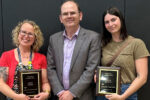Leadership Eugene Springfield
On March 13th Leadership Eugene Springfield held their Health and Human Services class, with the objectives to understand the current situation with health care access and changes happening, and to gain an overview of human services in our community. The day kicked off with a presentation on the local health care landscape by Oregon Medical Group CEO Karen Weiner. Dr. Weiner discussed health care models used by different providers in our area, and focused specifically on the changes OMG has gone through over the last several years in order to better serve their patients. Dr. Thomas Wuest of Trillium Community Health Plans, and Dr. Andrew Gilchrist of Direct Primary Care of Eugene discussed the very different models of patient care they provide. While we may not always see it, our community has many options when it comes to choosing our health care providers.
This class was graciously hosted by the Eugene Mission, the perfect place to learn about human services in our community. The Mission serves thousands of men, women and children each year. During our tour, the LES class got to meet new executive director Sheryl Balthrop, and learn all the ways we can help serve those in our community who need it most. The cohort also heard from panel of experts on human trafficking, including Tamara LeRoy with Lane County Task Force, Sanyelle Willson with Looking Glass Community Services, and Chris Luh, a Special Agent with the FBI. Beverlee Potter, Executive Director with FOOD for Lane County, and Tyler Mack, Director of Marketing and Development with Looking Glass also shared ways leaders in our community can get involved.
Dan Bryant, Executive Director of SquareOne Villages provided the closing presentation of our Health and Human Services Day. When looking at alternative housing, nothing seems quite as creative as SquareOne. SqareOne Villages encompasses two housing campuses, Opportunity Village and Emerald Village, both located a short distance from the Eugene Mission. These housing options provide low income individuals the opportunity to have their own unique home. These tiny homes are built using donated goods, volunteer labor, and creative design. They are located in their own small community, where residents can befriend their neighbors, and participate in community events.
Discover more from Springfield Bottom Line
Subscribe to get the latest posts sent to your email.



